|
Day 22
Jasper-Banff-Kamploops (In Progress)
Highlights
Day 22 was an action packed day and grueling for me as a driver with an early start just after 5 AM and did not end until 11 PM. We visited many waterfalls and lakes within short distances from the highway. We visited Jasper and Banff national parks, then drove through 2 more national parks before the day was over. A terrible accident somewhere ahead of us delayed the trip for some 3 hours. Then pouring rain hounded us from late afternoon to the night, making the drive treacherous, especially through narrow lanes at road construction sections. Even with all the visits and hikes we made, we still ended up beyond Kamploops and logged some 900 km in the process.
Day Journal
At first light, we started packing up the car tent at the roadside parking area. Since I wanted to catch sunrise somewhere, we headed out without preparing breakfast, hoping to find a restaurant along the way. Our journey began with visits in Jasper National Park, and ended with Lake Louise.
| Jasper National Park |
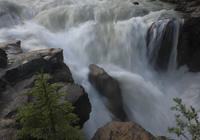 Our first stop was Sunwapta Falls of the Sunwapta River. The flow of this 80-ft high waterfalls was plenty strong despite the mid-summer timing meant it was off the spring melt peak or late spring. Sunwapta means turbulent water in native language. I took as short walk to see both the upper fall and lower fall. Our first stop was Sunwapta Falls of the Sunwapta River. The flow of this 80-ft high waterfalls was plenty strong despite the mid-summer timing meant it was off the spring melt peak or late spring. Sunwapta means turbulent water in native language. I took as short walk to see both the upper fall and lower fall. |
 In the early hours with mountains on both sides, the light hit the mountain peaks while the rest of the valley was still dark with a deep layer of thin fog made for dreamy scenery. In this picture, there was a distinct contrast of the silhouette of trees against the foggy background with the mountain peaks in soft glow. At other places, rivers reflecting lights also came to life next to the darker banks. In the early hours with mountains on both sides, the light hit the mountain peaks while the rest of the valley was still dark with a deep layer of thin fog made for dreamy scenery. In this picture, there was a distinct contrast of the silhouette of trees against the foggy background with the mountain peaks in soft glow. At other places, rivers reflecting lights also came to life next to the darker banks. |
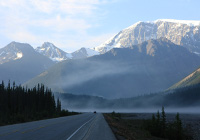 There were ample beautiful sceneries on our continuation south on the Icefield Parkway. The majestic mountains with glaciers towering over the road acquired a different dimension of mystique behind low fogs that huggedthe mountainside or spreaded over the road. There were ample beautiful sceneries on our continuation south on the Icefield Parkway. The majestic mountains with glaciers towering over the road acquired a different dimension of mystique behind low fogs that huggedthe mountainside or spreaded over the road. |
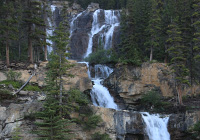 There were numerous waterfalls within short distance from the Icefield Parkway. Many such as Tangle Creek Falls can be seen from a roadside pullout. There were numerous waterfalls within short distance from the Icefield Parkway. Many such as Tangle Creek Falls can be seen from a roadside pullout.
We were so mesmerized by the dreamy landscape that we stopped several times along the side of the road to take pictures. The 30-mile drive to the Columbia Icefield took us just about 2 hours. |
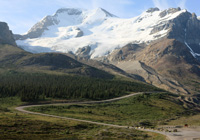 The sight of the icefield was awe inspiring. It's impossible to use the photographic format to render the grandeur of the scenery. And even with this breathtaking beauty, our first priority was a hot breakfast since our last meal was late afternoon of the previous day in Jasper. The food at Glacier View Inn was fair, and the service was slow, but the view from the restaurant window was fantastic. The sight of the icefield was awe inspiring. It's impossible to use the photographic format to render the grandeur of the scenery. And even with this breathtaking beauty, our first priority was a hot breakfast since our last meal was late afternoon of the previous day in Jasper. The food at Glacier View Inn was fair, and the service was slow, but the view from the restaurant window was fantastic.
After breakfast, we checked the schedule for the next available bus tour to the icefield, but decided to skip it due to lack of time. In another visit to the park, we will most likely take this bus tour to set foot on the glacier. |
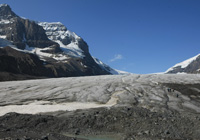 Instead of the bus tour, we drove to across the road from the Icefield Centre where we ate breakfast to a trail head and hiked roughly a km to the toe of the Athabasca Glacier, which was the only glacier clearly visible from the Icefield Parkway. The trek up to the glacier was a bit depressing with markers of where the toes of the glacier once were. It was hard to imagine the glacier reached all the way down to where the Icefield Center was in 1844. Now it took a drive to a parking lot and another 1 Km hike before we reached the base of the Athabasca Glacier. Instead of the bus tour, we drove to across the road from the Icefield Centre where we ate breakfast to a trail head and hiked roughly a km to the toe of the Athabasca Glacier, which was the only glacier clearly visible from the Icefield Parkway. The trek up to the glacier was a bit depressing with markers of where the toes of the glacier once were. It was hard to imagine the glacier reached all the way down to where the Icefield Center was in 1844. Now it took a drive to a parking lot and another 1 Km hike before we reached the base of the Athabasca Glacier. |
Banff National Park
After the hike to the toe of Athabasca Glacier, we continued our trip south, and soon entered Banff National Park. Of the many beautiful sceneries we saw, below were a selected few, listed in travel sequence south. |
 Bridal Veil Fall is a waterfall in Banff National Park, Alberta, Canada. It originates in the Huntington Glacier on the slopes of Cirrus Mountain. Its waters drain into Nigel Creek, then into the North Saskatchewan River at the Big Bend of the Icefield Parkway. Bridal Veil Fall is a waterfall in Banff National Park, Alberta, Canada. It originates in the Huntington Glacier on the slopes of Cirrus Mountain. Its waters drain into Nigel Creek, then into the North Saskatchewan River at the Big Bend of the Icefield Parkway.
It is a class 4 waterfall, with a drop of 1,200 ft (370 m) and a width of 20 ft (6.1 m). Source: wikipedia about Bridalveil Fall
|
 Nigel Falls can be seen right off the bridge, but many people missed it and just drive on through. One would need to park and take a short walk back to the bridge for a nice view since it's practically under the bridge. It should be warned that getting a nice view of the bridge would require a walk out to the bridge, a somewhat scary experience for someone with fear of height. Nigel Falls can be seen right off the bridge, but many people missed it and just drive on through. One would need to park and take a short walk back to the bridge for a nice view since it's practically under the bridge. It should be warned that getting a nice view of the bridge would require a walk out to the bridge, a somewhat scary experience for someone with fear of height. |
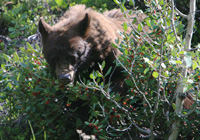 It's a safe bet that when you find traffic jam in a national park that there would be some wildlife in the area. Such was the case on this occasion as we saw lots of red lights and tour buses stuck in one place. And we did exactly what many people did - we found a place to park and looked where everyone else was looking. At first, we could not see anything. Then my wife saw him feeding behind a shrub. Eventually, I spotted him as well when he began moving. Seeing a grizzly bear munching on berries so close to the road was one of the most exciting moments of the trip. Forget about the 100-meter separation with bear rule. This guy was some 30 meters from the road and people were running back and forth to get a nicer view. He seemed oblivious to all the commotions, and continued feeding at a leisurely pace. After some 20 minutes, it started moving uphill which also let us move on with our drive. Thank you, bear for being a willing model! It's a safe bet that when you find traffic jam in a national park that there would be some wildlife in the area. Such was the case on this occasion as we saw lots of red lights and tour buses stuck in one place. And we did exactly what many people did - we found a place to park and looked where everyone else was looking. At first, we could not see anything. Then my wife saw him feeding behind a shrub. Eventually, I spotted him as well when he began moving. Seeing a grizzly bear munching on berries so close to the road was one of the most exciting moments of the trip. Forget about the 100-meter separation with bear rule. This guy was some 30 meters from the road and people were running back and forth to get a nicer view. He seemed oblivious to all the commotions, and continued feeding at a leisurely pace. After some 20 minutes, it started moving uphill which also let us move on with our drive. Thank you, bear for being a willing model! |
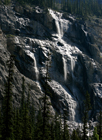 Weeping Wall is located right off the Icefield Parkway. There is a convenient parking area opposite the waterfalls. The information we found suggests that it can be spectacular after a major rain storm, or during the winter when the entire rock wall was covered by ice making it a popular destination for ice climbing. When we got to Weeping Wall, the light condition was almost right to see the water falling while the rock was somewhat dark. In my opinion, the view from just north of the wall was best in that light condition. Weeping Wall is located right off the Icefield Parkway. There is a convenient parking area opposite the waterfalls. The information we found suggests that it can be spectacular after a major rain storm, or during the winter when the entire rock wall was covered by ice making it a popular destination for ice climbing. When we got to Weeping Wall, the light condition was almost right to see the water falling while the rock was somewhat dark. In my opinion, the view from just north of the wall was best in that light condition. |
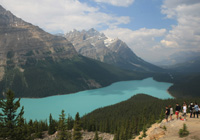 Peyto Lake was named after Bill Peyto, and early guide and trapper. The lake is fed by Peyto Glacier. It probably had the most unique color of our entire trip, counting even Emerald Lake near Carcross! The color looked so unreal that it seemed like someone dumped paint into the lake! The color comes from reflection of suspended glacial rock flour like many other alpine lakes in Canada. The degree of brightness was what set this lake apart from the rest we saw. The lake could be accessed after a short climb from a roadside parking lot. The parking lot was quite full when we were there. Peyto Lake was named after Bill Peyto, and early guide and trapper. The lake is fed by Peyto Glacier. It probably had the most unique color of our entire trip, counting even Emerald Lake near Carcross! The color looked so unreal that it seemed like someone dumped paint into the lake! The color comes from reflection of suspended glacial rock flour like many other alpine lakes in Canada. The degree of brightness was what set this lake apart from the rest we saw. The lake could be accessed after a short climb from a roadside parking lot. The parking lot was quite full when we were there. |
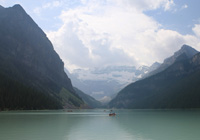 Lake Louise is one of the most famous lake in Canada. It's named after a princess. It's a very popular destination with a world-class Fairmont hotel practically on the bank of the lake. Despited prior warnings, we were still surprised by the huge crowd when we arrived. After circling for 15 minutes, we were lucky to get a parking spot. Another 15 minutes took us to the lake. And yes, it was overcrowded there too. In order to take pictures other than someone's back, I had to climb on a rock wall to get a better view. The view was indeed beautiful, with mountains and glaciers bordering the lake. I suppose if one hikes several miles up the mountains, some solitude could be had. We did not have that time, so after a few snapshots, it was time to hit the road. Lake Louise is one of the most famous lake in Canada. It's named after a princess. It's a very popular destination with a world-class Fairmont hotel practically on the bank of the lake. Despited prior warnings, we were still surprised by the huge crowd when we arrived. After circling for 15 minutes, we were lucky to get a parking spot. Another 15 minutes took us to the lake. And yes, it was overcrowded there too. In order to take pictures other than someone's back, I had to climb on a rock wall to get a better view. The view was indeed beautiful, with mountains and glaciers bordering the lake. I suppose if one hikes several miles up the mountains, some solitude could be had. We did not have that time, so after a few snapshots, it was time to hit the road. |
Heading to British Columbia
As we continued our journey, rain started pouring as we neared Glacier. This discouraged us from finding lodging in the area, and somehow turned off the exploring mood as well. Now, my desire was to get home, and to come back another time with more time and better weather to enjoy the many beautiful places Alberta and BC offer. Having swithed off the vacationing mode, I kept driving until late at night before looking for a place to stay. We finally found some place south of Kamloops. This particular night driving was treacherous for me due to the road condition, winding and narrow at places such as road works, and the constant heavy rains that stayed with us for most of the night. Below were a few highlights along the Trans-Canada Highway 1. |
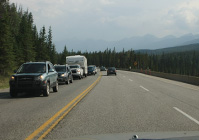 Departing Lake Louise, we started our way south toward the US, with the intention of staying overnight around (Canadian) Glacier National Park. Two things threw this plan off track - a major accident and bad weather. First, some accident ahead of us closed the Trans-Canada Highway 1 for some 3 hours. Everybody got stuck and there was no reasonable detour that could be found on the map. Several car made U turns, and probably went back to Lake Louise or Jasper - a thought that crossed our mind a couple of hours in to the wait. Finally, it cleared some 3 hours later, putting us way behind our plan. Departing Lake Louise, we started our way south toward the US, with the intention of staying overnight around (Canadian) Glacier National Park. Two things threw this plan off track - a major accident and bad weather. First, some accident ahead of us closed the Trans-Canada Highway 1 for some 3 hours. Everybody got stuck and there was no reasonable detour that could be found on the map. Several car made U turns, and probably went back to Lake Louise or Jasper - a thought that crossed our mind a couple of hours in to the wait. Finally, it cleared some 3 hours later, putting us way behind our plan.
|
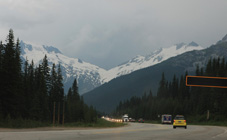 With the delay caused by the accident that closed the highway, we felt there would be no way to reach Glacier National Park before dark. We then found a roadside picnic area to have an early dinner while letting the heavy traffic thin out. We arrived at Rogers Pass near dusk under light rain and in no mood to find a place to stay. This was just a roadside stop to take a picture of the beautiful scenery. This park has some 400 glaciers covering some 12% of its total area. Although not big in size, it's a critical wildlife habitat. With the delay caused by the accident that closed the highway, we felt there would be no way to reach Glacier National Park before dark. We then found a roadside picnic area to have an early dinner while letting the heavy traffic thin out. We arrived at Rogers Pass near dusk under light rain and in no mood to find a place to stay. This was just a roadside stop to take a picture of the beautiful scenery. This park has some 400 glaciers covering some 12% of its total area. Although not big in size, it's a critical wildlife habitat. |
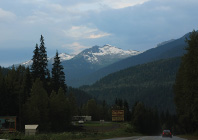 The sky actually cleared a little by the time we approached Revelstoke National Park. In all, we drove through at least 5 national parks before the day was over - Jasper, Banff, Yolo, Glacier and Revelstoke. The sky actually cleared a little by the time we approached Revelstoke National Park. In all, we drove through at least 5 national parks before the day was over - Jasper, Banff, Yolo, Glacier and Revelstoke.
This region was packed with places to explore. The two-day skimming of park attractions was enough for us to plan for a future return with a much longer stay. |
Road and Weather
The road was mostly good although winding and steep in sections through mountain national parks.
The weather was good albeit hazy through the early evening. As we approached Glacier NP and continuing beyond Kamploops, it was raining heavy at times.
Links and information sources
- Sunwapta Falls
- Columbia Icefield - A huge ice field comprising of 6 glaciers and straddles Jasper and Banff national parks. Several of the highest mountains are located around this ice field.
- Nigel Falls - a roadside waterfall in Banff National Park
- Peyto Lake - a bright turquoise colored lake in Banff National Park
- Lake Louise - One of the most famous recreational lake in Canada, with world-class hotel right next to the lake.
- Weeping Wall - a series of waterfall coming out of a vertical rock face that can be seen right off the Icefield Parkway in Banff National Park
- Glacier National Park -
In Progress: Posting pictures and videos from the segment.
|